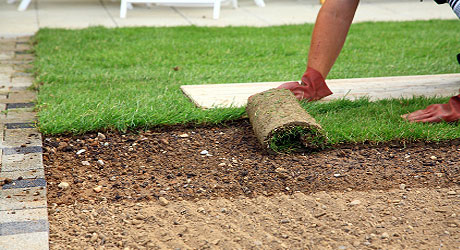Turf & Lawn Blog
What is the Best Time of Year to Lay Turf?
We are often asked what is the best time of year to lay turf. Like all living organisms, there are optimal conditions for growth. Turf is no exception to that rule. The way it’s treated affects how healthy it’s going to be and how it performs. The initial treatment of turf is thoroughly vital. If it’s neglected at the start, this can have dire consequences and it could end up dying. Imagine having to stop before you’ve even started!
So when is the correct time? Is there a specific day, like the 5th of April? Of course not, it depends on the conditions. But there are certain periods of the year which tend to consistently create certain productive environments for growing. According to the Royal Horticultural Society that time period is probably mid-autumn.
The truth is turf can be laid at any time of year, especially between early autumn and early spring. However, you can’t lay it when the ground is frosty or very wet. Which is why winter is often a challenge. Although it CAN be a good time to lay turf depending on what sort of winter the UK is having. Frozen ground will prevent plant growth and stop any vegetation emerging. Although Luckily it doesn’t have any substantial detrimental effects on the soil going forward.

It is best to avoid periods of high temperatures or drought. The lawn will require a lot of water and additional care and may be dry when delivered. This can make turf laying in July and August more challenging. In an ideal world turf should be laid when the ground is neither waterlogged or dry. This makes spring and autumn the best times of year.
There is a real reason why you have to wait for the ground to be dry and not frosty. Good preparation of the ground is crucial to getting a good lawn. This is not an overnight job, as you will need several weeks to ensure that all the weeds are gone, and that the ground has settled.
Gardener Self Preservation
You cannot neglect your own health when you are trying to look after the turfs. There can be the false impression that doing a bit of gardening is a breeze. It can be physically demanding at times, even if it is relaxing and therapeutic generally.
So you want to treat it as if you are preparing for an (extremely less taxing) marathon. Keep fluids nearby and keep topping up, ensuring you are fully hydrated. And I know it sounds simple but before you begin - EAT! Calories will be discarded as you create your perfect lawn quicker than you think.
Laying it down doesn’t need to become a painful practice - so avoid getting sunburn/sunstroke. Wear a hat, use suncream, even if the sun is barely out. Heat blisters could become a problem if you’re using tools. Use gardening gloves and remember - there is absolutely no rush.
How to prepare the site for turf
To start with, clear all the weeds from the site, especially perennial weeds such as bindweed and couch grass. You may find it helpful to use a good systemic weedkiller at this stage. This ensures that you have got rid of all the roots. Figure out how much turf is needed at any time of the year with our trusty calculator.
Dig over the site to about a spade’s depth or a little bit more, and dig in some well-rotted organic matter. Allow the ground to settle for a few days or weeks after digging, to ensure that your lawn surface will be level. Once you’ve done all this, tread the ground over several times to flatten it fully, and rake it to ensure that the soil is fine to encourage root growth.
Once your site is absolutely ready, and not before, you can buy your turf (see our online shop for prices). Most turf suppliers can supply good quality turf quite quickly, so you can have it delivered within a few days at most. Be ready to lay the turf as soon as possible after delivery, as turf is not good kept hanging about. For tips on laying your lawn well, take a look at our handy guide to laying turf.
Once you’ve laid your lawn, avoid walking on it for a few days, and longer if possible. Obviously if you’ve installed new lawn in these months, some of your visitors (or yourself) may want to have a walk around to test it! It is an exciting new addition after all.
If you’re laying lawn turf in spring, you also need to be aware that new turf often needs watering over summer. And you should avoid mowing it for as long as possible. Mowing before the grass has properly rooted, and allowing the grass to dry out, both stress the plants, and make it harder for the lawn to root properly. This is likely to lead to problems later, so is well worth avoiding.
When you subscribe to the blog, we will send you an e-mail when there are new updates on the site so you wouldn't miss them.
